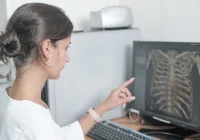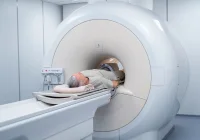Most lung cancer diagnoses in the United Kingdom follow symptom onset or emergency presentation and many people hesitate to seek help or struggle to access investigations. Self-request chest X-ray services in Leeds and Greater Manchester were created to lower these barriers by allowing eligible adults to attend radiology departments without a prior referral. Used more than 14,000 times, the model has reached communities with high levels of deprivation that face the greatest risks and obstacles. Early experience indicates that patient-initiated access can support timelier diagnosis and align with efforts to streamline care.
Why Earlier Access to Chest Imaging Matters
Lung cancer is the leading cause of cancer death in the UK and a major driver of health inequality. People in the most deprived areas of England are twice as likely to die from lung cancer as those in the least deprived areas. Late presentation contributes to this gap, with 45% presenting at stage IV and 32% diagnosed after an emergency presentation. A national low dose CT screening programme targets people aged 55–74 years at increased risk, yet fewer than half of those with lung cancer meet eligibility and only about half of those invited participate. Symptomatic pathways will therefore remain central to diagnosis.
National Institute for Health and Care Excellence Guidance recommends chest X-ray as the first investigation for common symptoms of possible lung malignancy with urgent referral if abnormalities suggest cancer. Indications set a low threshold, and liberal use is associated with better outcomes. Across 7,400 primary care practices, higher chest X-ray investigation rates correlated with fewer advanced stage diagnoses and lower risk of death within one and five years. In Leeds, a 2011 symptom awareness campaign increased community-requested chest X-rays by 81% and was associated with a 9% reduction in stage III and IV diagnoses, highlighting the potential of easier access for symptomatic people.
Must Read: France Launches Pilot for Equitable Lung Cancer Screening
Delays before seeking help, the “within patient” interval, account for more than half of the time from symptom onset to treatment. Contributing factors include low awareness of symptoms, perceived low personal risk, stigma linked to smoking, anxiety and barriers to accessing care. International comparisons show the UK public reports high barriers to evaluation, including embarrassment and fear of wasting a doctor’s time. Concerns that non-specific symptoms may be dismissed have been amplified by post-pandemic pressures. These dynamics reduce the likelihood of timely investigation even when guidance supports early chest X-ray.
How Self-Request Service Works
Self-request allows eligible adults to attend participating radiology departments on a walk-in basis. Services typically accept people aged 40 years or over who are registered with a local general practitioner and have at least one symptom aligned with guidance for investigation by chest X-ray including haemoptysis. On arrival, patients complete a brief form, and a radiographer confirms eligibility against a locally agreed protocol before imaging.
Compliance with Ionising Radiation (Medical Exposure) Regulations is ensured by an entitled referrer, which has varied between sites and may be a secondary care physician, the patient’s general practitioner or the assessing radiographer. The clinician responsible for receiving the report may be either the general practitioner or a secondary care physician. The Care Quality Commission advises each service to secure local Medical Physics approval and maintain clear written protocols with audit. Given the limited sensitivity of chest X-rays for lung cancer, patients receive safety-netting advice to seek help if symptoms persist or worsen to avoid false reassurance.
Result communication is tailored locally. Some services send verified reports to the general practitioner with a statement that the patient self-requested the examination, ensuring practices are aware an investigation occurred. Others issue a standardised letter to patients indicating whether further tests or treatment may be needed and advise prompt contact with general practice. Results are viewable through the NHS App and teams are collecting feedback to refine processes.
Early Reach, Equity and Workload Considerations
The longest-running services in Leeds and Greater Manchester have been accessed more than 14,000 times. Convenience and reassurance are the most common reasons for attendance. The mean age of users is 62 years and 51% are current or former smokers. Importantly, 38% come from the highest quintile of social deprivation and 16 first languages have been recorded, indicating reach into higher risk communities rather than concentration among the worried well. Promotion has involved public health teams, local press, social media and multilingual materials such as Bengali and Urdu, with integration into pathways like NHS 111 under evaluation. Approximately 1% of attendees are diagnosed with lung cancer through self-request and the two-year underlying probability among all attendees is 1.5%, comparable to 1.4% among general practitioner-referred chest X-rays. Comparative outcome analyses are underway.
Local configurations reflect operational context. In Leeds, the service began in 2011, paused from 2019 to 2021 and has involved West Yorkshire partners including the Integrated Care Board, Cancer Alliance and public health. In Greater Manchester, the Northern Care Alliance NHS Foundation Trust provides the service with the Cancer Alliance as a partner, serving populations in Bury and the Heywood, Middleton and Rochdale localities. Eligibility typically requires age 40 or over with defined symptoms persisting for three or more weeks and no recent chest imaging.
Workload effects have been reviewed where the model is longest established. In Leeds, self-request examinations accounted for 5% of community-ordered chest X-rays between 2011 and 2015. Most examinations are normal or show benign findings that need no action, while up to 7% reveal results that require clinical assessment or follow-up imaging arranged by the general practitioner. Although this can add tasks for primary care, many patients avoid an initial pre-test consultation and findings suggestive of lung cancer trigger automatic recall for CT through an electronic pathway. Cases are discussed at multidisciplinary team meetings to standardise care and limit overdiagnosis.
Lowering barriers to first-line imaging offers a pragmatic lever for earlier lung cancer diagnosis and for addressing inequalities linked to late presentation. The self-request chest X-ray model provides a protocol-driven route for symptomatic adults to secure timely imaging without prior referral while preserving regulatory compliance and safety-netting. Early experience shows scale, reach into deprived communities and diagnostic yields comparable to established routes. As comparative outcomes emerge, leaders can judge how this approach fits within lung cancer pathways, service capacity and public health strategies to support timely diagnosis and better outcomes.
Source: British Journal of Radiology
Image Credit: iStock










